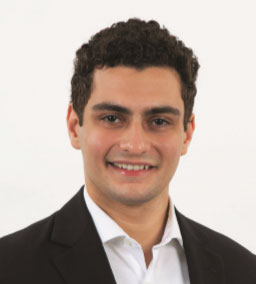POLINA POTOCHEVSKA, EDITORIAL INTERN
 The breadth of possible applications in photonics makes Jeremy Staffa excited to witness what he believes could be “one of the most influential fields of the next decade.” He is a doctoral student at the Institute of Optics at the University of Rochester, where he also earned a Bachelor of Science and a Master of Science in optics.
The breadth of possible applications in photonics makes Jeremy Staffa excited to witness what he believes could be “one of the most influential fields of the next decade.” He is a doctoral student at the Institute of Optics at the University of Rochester, where he also earned a Bachelor of Science and a Master of Science in optics.
As a first-year undergraduate, Staffa was undeclared in his major, he told Photonics Media. But the optics department soon caught his attention. After conducting quantum optics research for his senior thesis and researching optical communications at NASA in between his bachelor’s and master’s degrees, Staffa said his enthusiasm for the field led him to pursue a doctorate instead of jumping into a career.
Currently, he works at Rochester’s Laboratory for Nanophotonics, which is led by professor Qiang Lin. The Lin group focuses primarily on novel nonlinear optical, quantum optical, and optomechanical phenomena in micro- and nanoscopic photonic structures, as well as on the potential applications for these technologies in chip-scale photonic signal processing and sensing, Staffa said.
He has a special interest in photonic integrated circuits as a platform for quantum and nonlinear photonic devices and functionalities.
“In particular,” Staffa said, “our group specializes in the lithium niobate (LiNbO3) material platform due to its outstanding properties for these applications,
such as large χ(2) and χ(3) nonlinearities, a wide transparency window, negative uniaxial birefringence, and the ability to be periodically poled.” Many potential applications exist for lithium niobate nanophotonics platforms in communications, photonic signal processing, quantum technology, and other fields.
In Lin’s lab, each member is encouraged to cultivate expertise in nanophotonic device research from start to finish. For example, researchers will derive their own theoretical models, design and simulate devices, fabricate them at the Cornell Nanoscale Science and Technology Facility, and test them in the lab. This way, the scientists can gain the big picture view instead of just seeing the individual steps in the process. The team also collaborates and conducts frequent brainstorming sessions to discuss future projects.
Staffa said lab research has continued during the COVID-19 pandemic, and the downtime has even brought advantages. “It has been a great time to focus on deriving novel theoretical results and simulate new device designs, as well as acquaint myself with more literature from the field and attend virtual conferences. I’m excited for when laboratories and other facilities start opening up more after the pandemic and these new projects can be fabricated and tested in the lab.”
Until then, he said he will focus on balancing the demanding studies and workload that a doctoral program entails. While most of Staffa’s day is spent researching, other jobs need to be completed as well, including serving as a teaching assistant, creating problem sets, or studying for exams. He recognizes the need to maintain a work-life balance and the benefits of setting aside time to relax and unwind. “High-quality recreational time will make you so much more productive during work hours than if you had tried to just work around the clock instead,” he said.
In the future, Staffa said he believes integrated photonics will become a disruptive technology in application spaces that microelectronics already address. He sees nanophotonics as the key enabling technology for a variety of applications, even though it may receive less media coverage compared to other technologies, such as quantum computing or machine learning.
“I think photonic qubits will be able to catch up with the excellent demonstrations that have already been done with superconducting qubits, or at least establish itself as an important complementary platform in a mature quantum computer,” Staffa said. “I believe photonics will be one of the most influential fields of the next decade, and so I’m excited to see the breadth of application spaces in which nanophotonics technology finds a home in the near future.”
Staffa is passionate about helping the nanophotonics field to find its place in commercial markets, and he said he finds it fascinating to research a topic while it is maturing from a scientific research subject into a platform for practical innovations. On top of his doctoral program, Staffa is also earning a Master of Science degree in technical entrepreneurship and management with the Simon Business School at Rochester. He said this will help him learn to translate scientific discoveries into tractable business plans, and he looks forward to achieving these dual perspectives upon his graduation.